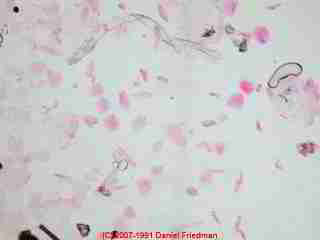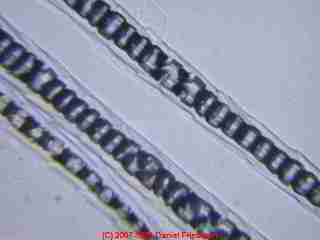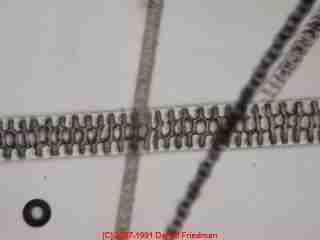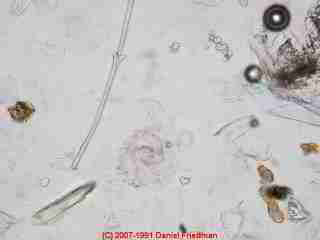 Building Inspection & Test Procedures for Pet Allergens & Allergen Exposure
Building Inspection & Test Procedures for Pet Allergens & Allergen Exposure
- POST a QUESTION or COMMENT about when, where & how to inspect for & test for animal-related allergens in buildings
Approaches to testing buildings for animal allergens:
This article describes how we perform a visual inspection and simple testing for the presence of high levels of animal allergens (dogs, cats, mice, birds) in buildings.
People often ask us how to test a building or home for cat, dog, or other animal allergens. This article explains and provide photos of common indoor allergenic particles found in homes and in the work place.
During building air quality inspections we often find evidence of cats, dogs, mice, birds, and other animals who have been frequently present in a home even though the human occupants didn't know it - either because the animal was the pet of a prior owner (chinchilla hair in photo below left at How to Test) or a nocturnal visitor to the food bins (mouse hair in photo below right at How to Test)).
When we find evidence of the past presence of animals in a building, additional cleaning might needed to reduce their remaining allergenic particles.
InspectAPedia tolerates no conflicts of interest. We have no relationship with advertisers, products, or services discussed at this website.
- Daniel Friedman, Publisher/Editor/Author - See WHO ARE WE?
Allergen inspection & testing in buildings: how to find evidence of animal allergens indoors
Discussion here includes a review of evidence of Animals in Buildings: A List of Clues Indicating Past or Present Pets or Animals in buildings.
Our photos show skin cells (above) and dog and cat dander (below) stained pink with acid fuchsin.
How do You Test or Screen Buildings for Animal Allergens? IAQ: What Else Should You Check in Indoor Air & Dust Besides Animal Allergens?
Check With Your Doctor About Allergens and About Whether or Not Building Tests for Allergens or Mold are Recommended.
Animal dander in homes is a common source of respiratory irritants associated with asthma and allergies. Animal dander, hair, and other organic debris in homes can also result in a significant increase in the level of dust mites, mite fecals, and other allergenic insect parts and fragments.
These two lab photos of human skin cells, animal skin cells (dander), and other debris are typical of a home where pets have been resident. The left photo includes a feather barbule fragment and insect fecals. The right photo shows skin cells and animal dander.

How to Inspect & Test For Dog, Cat, & Other Building Allergens


Evidence of Animals in Buildings: A List of Clues Indicating Past or Present Pets or Animals in buildings
A List of Clues of Prior Animal Presence in a Building
While more sophisticated tests are available, simple adhesive tape sampling accomplishes this easily and is inexpensive.
During an inspection I also look for evidence of the pet history in the home - often there are left-over visual indicators even when pets are long gone or when recent owners didn't even have a pet. It may be important to look for evidence of animals other than pets, such as squirrels, mice, rats, insects, and birds, some of which can bear seriously harmful pathogens. Some telltales of prior animal or pet occupancy in a building include the following:
- Animal stains: grease, urine stains, marks of passage by doorways or sleeping areas. Animal stains may be seen on walls, trim, doors, carpets
- Remaining animal hair - even after cleaning, may show up in building dust or vacuum samples if collected with care
- Remaining cat litter can indicate that cats were present
- Pet doors
- Animal waste: outside around a home, inside the home, and in crawl spaces and attics (rodents, squirrels, raccoons, birds)
- Scratch marks doors, furniture, trim
- Stains on or damage to furniture (scratches, tears)
- Animal odors
- High levels of dust may indicate one or more dogs or other "indoor-outdoor" animals. I've found "dog dust" (a very find soil dust brought indoors by dogs, especially long-haired dogs) thick in building attics and even inside building wall cavities in buildings where multiple animals have been romping or living.
How do You Test or Screen Buildings for Animal Allergens?
Some Simple Building Tests for Animal Allergens - Screening for Allergenic Particles
The International Association of Allergology and Clinical Immunology (IAACI), also referred to as the World Allergy Organization, recommend collecting settled indoor dust to evaluate indoor building exposure to dust mite and other allergens. Dust mite allergens, a specific component of dust allergen surveys, are designated as Der P 1 and Der F1.
High levels of dust mite allergens are associated with asthma or allergic sensitization and bronchial hyperactivity. Although dog allergens, Can F 1 (Canine F1), exceed the low characterization, reaction to canine allergens is considered variable, ranging from 1-20 as significant. Cat allergens are actually more of a concern for many people than dog allergens.
See CAT DANDER for details.
There are chemical tests and assays for proteins in the dander of cats and dogs that check for the level of allergens in a building. But like any sophisticated chemical test or particle analytics which may appear to give very precise results (say a number to several decimal places), the results may be very inaccurate.
See ELISA and RAST
That is because in collecting building samples, almost everything depends on exactly where and how a sample is collected. To be accurate the sample must represent the actual conditions in the building and must accurately assay the probable level of exposure of occupants to the material being tested for.
Because of the risk of highly-inaccurate but costly "allergen tests", when I'm asked to inspect a property to assess the level of animal allergens present, I prefer to combine a thorough visual inspection with the information about the building history, prior occupants, any building-related complaints of the present occupants, along with the collection of carefully chosen building dust screening samples in which we look for high levels of animal dander or other diagnostic particles.
An "air test" to screen for animal allergens would be quite unreliable in addressing this question. Collect settled dust that represents building conditions and look for dominant particles and relative percentages of particles rather than "an airborne particle count".
OPINION-DF: We like to collect individual dust samples from representative building areas where we suspect a high allergen presence, and screening dust samples from rooms where building occupants spend the most time. That approach permits building diagnosis by identifying problem areas and their effect on other building areas.
OPINION-DF: An alternative to collecting settled dust from individual surfaces is to collect a composite dust sample by using an air-filter type cassette or a vacuum cassette that samples from multiple areas as a more general building screen, but if such a test comes back as "action needed" either we need to repeat the tests with more attention to individual areas, or the cleaning and action advice for the building will have to be very general.
What Else Should You Check in Indoor Air & Dust Besides Animal Allergens?
When screening a building for evidence of a high level of animal allergens, at the same time we look for the following:
- high levels of dust mite fecals
- high levels of insect fragments (cockroach, for example)
- the level of feather barbules and fragments
- the level of rodent presence (openings, gnaw marks, urine odors, droppings, odor, traps, mouse or rat animal dander) - also
see FIBER & HAIR IDENTIFICATION - the presence of materials commonly considered allergenic to some people: feather comforters, wool, lots of wall to wall carpets
- the general moisture level and leak history in the building (high moisture invites both mold contamination and higher levels of dust mites)
- the condition of the HVAC system air handler, duct work, filters, and filtration system
Check With Your Doctor About Allergens and About Whether or Not Building Tests for Allergens or Mold are Recommended
Of course since individual sensitivity to allergens varies, we suggest that anyone suffering from allergies and considering steps to further clean their home should also consult with their allergist and their general physician.
- Safety Warning: if indoor air quality complaints include respiratory distress, headaches, nausea, and similar symptoms, it is important to immediately rule out unsafe heating equipment, chimneys, flues, or carbon monoxide hazards.
See CARBON MONOXIDE - CO. - The types, accuracy, and variability of human tests for allergy sensitivity and allergy or mold exposure are discussed further
at ALLERGY TESTS. - The combination of allergy testing limitations and occupant complaints that may in some cases justify a building survey for physical particles or other evidence of significant levels of problem allergens, molds, or other conditions is discussed
at ALLERGY TEST LIMITATIONS. - See MOLD EXPERT, WHEN TO HIRE for advice on determining when it is appropriate and justified to order inspections and tests of a building for mold or allergens.
- See BIOLOGICAL POLLUTANTS for information about recognizing and removing these indoor contaminants.
- See ENVIRONMENTAL HAZARDS - INSPECT, TEST, REMEDY for our full list of environmental hazard identification and remedy related to buildings.
...
Continue reading at ALLERGY TESTS for PEOPLE or select a topic from the closely-related articles below, or see the complete ARTICLE INDEX.
Or see these
Allergen Articles
- ALLERGENS in BUILDINGS - home
Suggested citation for this web page
ALLERGEN TESTS for BUILDINGS at InspectApedia.com - online encyclopedia of building & environmental inspection, testing, diagnosis, repair, & problem prevention advice.
Or see this
INDEX to RELATED ARTICLES: ARTICLE INDEX to BUILDING ALLERGENS
Or use the SEARCH BOX found below to Ask a Question or Search InspectApedia
Ask a Question or Search InspectApedia
Questions & answers or comments about about when, where & how to inspect for & test for animal-related allergens in buildings.
Try the search box just below, or if you prefer, post a question or comment in the Comments box below and we will respond promptly.
Search the InspectApedia website
Note: appearance of your Comment below may be delayed: if your comment contains an image, photograph, web link, or text that looks to the software as if it might be a web link, your posting will appear after it has been approved by a moderator. Apologies for the delay.
Only one image can be added per comment but you can post as many comments, and therefore images, as you like.
You will not receive a notification when a response to your question has been posted.
Please bookmark this page to make it easy for you to check back for our response.
IF above you see "Comment Form is loading comments..." then COMMENT BOX - countable.ca / bawkbox.com IS NOT WORKING.
In any case you are welcome to send an email directly to us at InspectApedia.com at editor@inspectApedia.com
We'll reply to you directly. Please help us help you by noting, in your email, the URL of the InspectApedia page where you wanted to comment.
Citations & References
In addition to any citations in the article above, a full list is available on request.
- MedicineNet.com provides a detailed definition of ELISA at www.medterms.com/script/main/art.asp?articlekey=9099
- "IgG Food Allergy Testing by ELISA/EIA, What do they really tell us?" Sheryl B. Miller, MT (ASCP), PhD, Clinical Laboratory Director, Bastyr University Natural Health Clinic - ELISA testing accuracy: Here is an example of Miller's critique of ELISA http://www.betterhealthusa.com/public/282.cfm - Townsend Letter for Doctors and Patients
The critique included in that article raises compelling questions about IgG testing assays, which prompts our interest in actually screening for the presence of high levels of particles that could carry allergens - dog dander or cat dander in the case at hand.
http://www.tldp.com/issue/174/IgG%20Food%20Allergy.html contains similar criticism in another venue but interestingly by the same author, Sheryl Miller. Sheryl Miller, MT (ASCP), PhD, is an Immunologist and Associate Professor of Basic and Medical Sciences at Bastyr University in Bothell, Washington. She is also the Laboratory Director of the Bastyr Natural Health Clinic Laboratory. . Sheryl Miller, MT (ASCP), PhD, is an Immunologist and Associate Professor of Basic and Medical Sciences at Bastyr University in Bothell, Washington. She is also the Laboratory Director of the Bastyr Natural Health Clinic Laboratory. - Testing for the level of exposure to animal allergens is discussed at http://www.animalhealthchannel.com/animalallergy/diagnosis.shtml (lab animal exposure study is interesting because it involves a higher exposure level in some cases
- World Allergy Organization,
(or see this better website for WAO)International Association of Allergology and Clinical Immunology, WAO Secretariat 555 East Wells Street, Suite 1100, Milwaukee, WI 53202-3823 U.S.A., Phone: +1 414 276 1791 Fax: +1 414 276 3349 E-mail: info@worldallergy.orgQuoting:
IAACI-WAO is an international umbrella organization whose direct members are 49 national allergology and clinical immunology societies and 4 affiliate organizations from around the world. The Association was founded in 1951 at the occasion of the First International Congress of Allergology which took place in Zurich. The Association has successfully organized fifteen major congresses which are held on a triennial basis.
IAACI-WAO has been expanding its purview in a more direct effort to bring together the member allergologists and clinical immunologists who are engaged in research and/or practice throughout the world. Through its various committees, the Association now provides advice and active support intended to build a global alliance of allergy societies to advance excellence in clinical care, research, education and training. Its position in the scientific community is enhanced by being a member of the Council for International Organizations of Medical Science (CIOMS) and by its working relationship with the World Health Organization (WHO). IAACI-WAO is also an associate member of the International Union of Immunological Societies (IUIS), which is the major association of immunologists in the world. IAACI-WAO regularly sponsors scientific symposia in developing areas throughout the world, and jointly sponsors postgraduate programs featuring state-of-the-art information on allergology and clinical allergology during professional, non-allergy association congresses throughout the European Community.
Quoting WAO:
WAO offers online education for allergists/immunologists around the world. This module on food allergy consists of an interactive case history based on a real life scenario. Key questions are asked on each aspect of the case. The answers are supported by references to WAO and other learning materials and cutting edge reviews and research papers available online. CME credit is available by completing a multiple choice questionnaire. - "IgG Food Allergy Testing by ELISA/EIA, What do they really tell us?" Sheryl B. Miller, MT (ASCP), PhD, Clinical Laboratory Director, Bastyr University Natural Health Clinic - ELISA testing accuracy: Here is an example of Miller's critique of ELISA http://www.betterhealthusa.com/public/282.cfm - Townsend Letter for Doctors and Patients
The critique included in that article raises compelling questions about IgG testing assays, which prompts our interest in actually screening for the presence of high levels of particles that could carry allergens - dog dander or cat dander in the case at hand.
http://www.tldp.com/issue/174/IgG%20Food%20Allergy.html contains similar criticism in another venue but interestingly by the same author, Sheryl Miller. Sheryl Miller, MT (ASCP), PhD, is an Immunologist and Associate Professor of Basic and Medical Sciences at Bastyr University in Bothell, Washington. She is also the Laboratory Director of the Bastyr Natural Health Clinic Laboratory. - Allergens: Testing for the level of exposure to animal allergens is discussed at http://www.animalhealthchannel.com/animalallergy/diagnosis.shtml (lab animal exposure study is interesting because it involves a higher exposure level in some cases
- Allergens: WebMD discusses allergy tests for humans at webmd.com/allergies/allergy-tests
- In addition to citations & references found in this article, see the research citations given at the end of the related articles found at our suggested
CONTINUE READING or RECOMMENDED ARTICLES.
- Carson, Dunlop & Associates Ltd., 120 Carlton Street Suite 407, Toronto ON M5A 4K2. Tel: (416) 964-9415 1-800-268-7070 Email: info@carsondunlop.com. Alan Carson is a past president of ASHI, the American Society of Home Inspectors.
Thanks to Alan Carson and Bob Dunlop, for permission for InspectAPedia to use text excerpts from The HOME REFERENCE BOOK - the Encyclopedia of Homes and to use illustrations from The ILLUSTRATED HOME .
Carson Dunlop Associates provides extensive home inspection education and report writing material. In gratitude we provide links to tsome Carson Dunlop Associates products and services.


